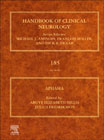
Aphasia, Volume 185 covers important advances in our understanding of how language is processed in the brain and how lesions or degeneration in the left hemisphere affect language processing. This new release reviews research regarding how language recovers from brain injury, along with new interventions developed to enhance recovery, including language rehabilitation, noninvasive brain stimulation and medications. Sections cover neuroanatomy and neurophysiology of language networks, focus on mechanisms of recovery (and decline) of language, and include chapters on intervention, including recently developed behavioral therapies, brain stimulation, medications, and a review of studies of treatment for both post-stroke aphasia and primary progressive aphasia. Summarizes advances made in understanding language processing Discusses how lesions and brain degeneration affect language production and comprehension Identifies language networks based on functional imaging and lesion mapping Provides interventions for recovery, including brain stimulation, behavioral interventions and medication Explores post-stroke aphasia and primary progressive aphasia INDICE: Section 1. History and Conceptual Models of Language and the Brain1. History of aphasia: A broad overview2. Broca-Wernicke theories: A historical perspectiveSection 2. Neuroanatomy of Speech and Language3. Vascular syndromes: Revisiting classification of post-stroke aphasia4. The dual stream model of speech and language processing5. Types of motor speech impairments associated with neurologic diseases6. Clinical and neuroimaging characteristics of primary progressive aphasia7. The role of disrupted functional connectivity in aphasia8. The role of disrupted structural connectivity in aphasiaSection 3. Language Recovery 9. Functional MRI evidence for reorganization of language networks after stroke10. The contribution of positron emission tomography to the study of aphasia 11. Electrophysiologic evidence of reorganization in post-stroke aphasia12. Assessment of language impairment and function Section 4. Language Intervention13. Behavioral interventions for post-stroke aphasia 14. Behavioral interventions for primary progressive aphasia 15. Noninvasive brain stimulation to augment language therapy for post-stroke aphasia 16. Noninvasive brain stimulation to augment language therapy for primary progressive aphasia 17. Better language through chemistry: Augmenting speech-language therapy with pharmacotherapy in the treatment of aphasiaSection 5. Recent Advances18. Ethical considerations in the management of post-stroke aphasia19. Genetics in aphasia recovery20. Sign language aphasia
- ISBN: 978-0-12-823384-9
- Editorial: Elsevier
- Encuadernacion: Cartoné
- Páginas: 336
- Fecha Publicación: 16/05/2022
- Nº Volúmenes: 1
- Idioma: Inglés
